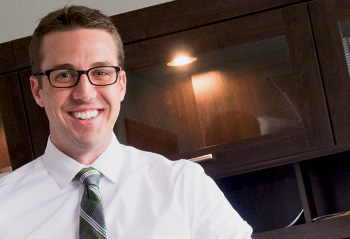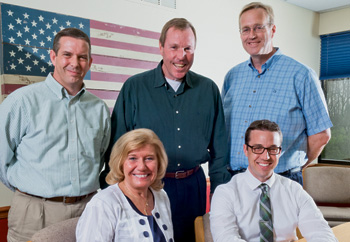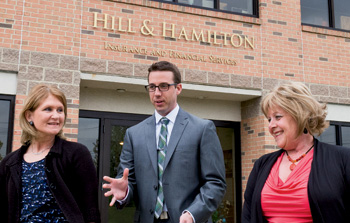Simon says: Communicate!
PIA's Young Insurance Professional award winner is "bilingual" across generations
By Sue R.A. Honeyman
Matt Simon, vice president of Hill & Hamilton Insurance and Financial Services in Bellefontaine, Ohio, recently was named the 2013 PIA National Young Professional of the Year—because he is bilingual.
If this seems an unusual criterion for so prestigious an award, it makes sense when you know that his bilingual skills are not in speaking the languages of different nations. Instead, they involve communicating effectively with the over-35 generation as well as the under-35 generation, and Simon is becoming the Ohio PIAA's chief practitioner and proponent of this type of communication.
When communicating with current and prospective clients, Simon, who is 31, sees both similarities and differences among the generations. "People, no matter their age, appreciate that we're acting as their advisors. Each wants the same advice and same guidance from their independent agent—but wants it delivered in a different way." Being there the way your customer wants—that's the challenge.
For example, he has clients from his school years who chose to begin a business relationship "not by picking up the phone, not by sending an e-mail but by logging on to my agency's Web site and submitting information about what they needed. Had we not had a Web site to address the questions they had, I'm not sure we would have had this relationship," he remarks.
In Simon's view, many in the industry misjudge how the Internet is used in the insurance process by assuming that Internet users, especially those under age 35, simply want to log on and buy their insurance online. In reality, the Internet is just another tool. Buyers are doing their research online to learn about their needs and your agency before they decide whom to talk with. "We try to provide as much information as we can about all the different types of insurance, so when it moves beyond research, they will contact us," he says.
This process is not very different from that of his parents' generation of buyers, who would talk with an agent at networking groups like the Chamber, Kiwanis and Rotary, or would speak to an agent on the phone many times before actually coming in to the agency to purchase a policy, Simon observes. That is a good thing. Buyers who use the Internet for research often make the best prospects because they value the agent's advice and tend to become loyal customers. The pure Internet buyer tends to be highly price-sensitive, to purchase state minimum limits that agents usually find inadequate for client needs, and to switch often—not the best fit for an independent agent.
Simon believes that independent agents should not fear technology, but embrace it and use it to provide the higher level of service that clients, especially younger clients, expect. He has difficulty understanding why the heavily regulated banking industry routinely provides customers round-the-clock, online access to their accounts, yet few agencies do this. Clients should be able to print out an insurance card or check their policies online if they choose, rather than calling their agent for routine service. It's more efficient for everyone and will not detract from the essential advisory role of the agent. In fact, such efficiencies will allow more time for agents to proactively review clients' protection needs, cross-sell products, update their Web site and strategically engage in social media—activities that promote client retention and new business acquisition, Simon points out.
Communicating with clients
Simon's cross-generational communications skill was clearly demonstrated with the agency's homeowners clients in late 2011. A large number of storms, including wind, hail, hurricanes and tornadoes, caused significant property damage, and Simon knew that insurers would respond in ways that were sure to upset or anger clients. Anticipating increased rates, higher deductibles and a switch to actual cash value settlements on roof claims, he faced a choice: sit back and wait for clients to get their renewal notices or warn them in advance of what was coming.
"We took the proactive approach of telling our clients that these changes are coming and we can't stop it—but we can help you be better prepared," Simon says.
Among other things, he posted an article, "Weather Claims in 2011 Causing Home Insurance Rate Changes" on his agency blog in October 2011, quantifying storm damage and relating it directly to clients.
He wrote: "Through June of 2011, there have been more than $17.3 billion in claims associated with catastrophe losses. This number exceeds the amount for the entire 2010 year. With so many claims being filed, insurance companies have no alternative but to begin increasing the premiums they charge."
Simon's article went on to assure clients that there were steps they could take to control their costs, and he offered them his report, "7 Steps to Prepare for Your Home Insurance Renewal." Others could receive the report after providing some information, so there was a marketing element as well.
He and others at the agency expected a lot of angry calls and e-mails about what was happening, but while they did get a lot of calls and e-mails, these tended to be positive and to indicate that insureds were happy to get the information.
A particularly useful piece of advice he supplied was to avoid filing a claim for a small payout because premium increases would have a greater effect on clients who had claims than on those who had not, he said. Thus, if you have a $1,000 deductible and you have a $1,200 claim, you are probably better off absorbing it on your own. If you file the $1,200 claim and recoup $200 but later have a $10,000 claim, there's no question you'll turn that second claim in, "but now the insurance company will be looking at you as having two claims, not one," he said. "An insurance company will be more likely to work with you if you've had one claim rather than two or three, and they might even refuse to renew the policy, so you'll have to find coverage from another carrier that will charge drastically more than you paid before."
Business focus
Simon is from an insurance family, but one where everyone is traditionally encouraged to find his or her own path. His grandfather, in fact, tried 13 different jobs in 12 months before finding the right position as a tool grinder at General Motors, where he stayed for 40 years. His father, Tom, is the president and owner of Hill & Hamilton, founded in 1920, and his mother, Andrea, is the bookkeeper; but Tom makes it clear that the family doesn't discuss work outside the office and that he and his wife will neither expect nor encourage any of their children to become agents.
Matt had several summer jobs where he got his hands dirty, but he got his feet wet in insurance as a summer intern at Cincinnati Insurance and at Hill & Hamilton. After graduating summa cum laude from Wittenberg University in Springfield, Ohio, with a degree in business management and economics, he joined Motorists Mutual Insurance Group in Columbus, Ohio, where he acquired both the CPCU designation and technical underwriting skills. Two years later, he surprised his father by asking to join his parents' agency. Matt's siblings work in other fields: His sister does communications and public relations for an independent automotive proving ground company, while his brother is a commercial bank analyst.
Hill & Hamilton is a traditional small-town agency with a broad book of business based mostly on geography. When Matt came on board, he quickly realized that he needed a strategy to succeed. Of course, he could continue the agency's existing client relationships by providing the high level of service they'd come to expect, but it's essential also to acquire new business, and doing that in such a competitive environment was difficult. "I found that if you called on a business, you'd be one of 10 or 12 agencies that they would hear from in a month, all trying earn their business," Matt comments. He did notice, though, that medical malpractice was far less competitive and offered a way for him to get his foot in the door and build a book of business fairly quickly.
Why medical malpractice? Because while many insurers focus on larger accounts, the practices with one, two, or three physicians were somewhat of an underserved class in Ohio, and Matt found that he could readily get in to see them. They weren't accustomed to an agent sitting down with them, asking a lot of questions, and then providing the level of service, guidance and advice that Matt offered, so they signed on. He generally pursues this niche within a 60-mile radius of the agency but has written accounts throughout the state through client referrals.
Tom Simon is particularly proud of the professionalism Matt displays, especially Matt's "empathy and commitment to researching all the facts before he acts." Tom notes: "It's probably not the accounts you write that determine success or failure, but rather the ones you choose not to write, the ones that aren't a good fit."
Matt became involved with PIA when John Burtch, president of Dawson Transportation Services in Columbus, Ohio, invited him to a meeting of the Ohio PIAA Agent Resources Committee to present the perspective of the younger insurance professional. Matt was impressed with how the group listened to his opinions and concerns and actually implemented some of his suggestions. Burtch was impressed with Matt's insights and leadership skills and recommended him for the PIAA board of directors, which Matt joined in 2011. Burtch wrote in a letter supporting Matt's award, "I feel better about the future of the independent agency system knowing young men such as Matt Simon are entering leadership roles in our association."
Matt's industry involvement goes beyond the Ohio PIAA. Since 2008, he has been state director of Associated Risk Managers (ARM) of Ohio, a network of smaller agencies that pool resources to gain access to good markets, programs and other resources for clients. He's also a member of the agent advisory council for State Auto Insurance Companies.
The PIA Young Leadership Award is often given to someone who attracts an impressive number of young people to become agents or to become involved in the organization, but Simon's nomination is less about numbers and more about communicating ideas across the age divide.
George Haenszel, CEO of PIAA of Ohio, described the impact of Simon's "bilingualism" on the association. In his letter nominating Simon, Haenszel wrote: "Young agents want to be around him to learn from his experience and insights. So do older agents, but for a different reason. Matt embraces technology, the changing insurance environment and demographics. He can explain the new environment in a way that older agents understand. He affects other agents because his insights are encouraging, and they don't feel as if they are aging victims of change."
The author
Susan R.A. Honeyman is a freelance writer based in New Haven, Connecticut, and is vice president of Word Hive Communications LLC.
"Each person, no matter their age, wants guidance from their independent agent but wants it delivered in a different way."
—Matt Simon
Coming from a family of insurance professionals, Matt credits his family roots in the industry for much of his success. He is surrounded here by family members Andrea L. Simon, mother; and (standing from left to right), Mark A. Osborne, uncle; Thomas J. Simon, father; and Jim Simon, uncle. Jim works for his own agency, Simon Insurance Agency, while the others are Hill & Hamilton associates.
Matt with two Hill & Hamilton CSRs (from left) Gina A. Loehr, AAI, and Marilyn L. Springs.




